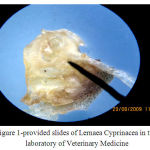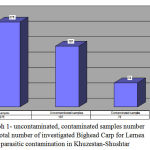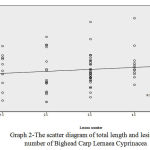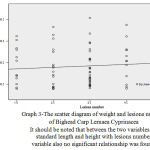Sadeghi Limanjoob Reza1*,Farzam Mohsen2 ,Jamali Houshang3 , Syahmard Nahid4, kargar Jahromi Hossein5 and Farzam Mohammad2
1Department of Aquatic Animal Health, Veterinary School, Kazerun Branch, Islamic Azad University, Kazerun, Iran.
2Department of Physiology, Veterinary School, Kazerun Branch, Islamic Azad University, Kazerun, Iran.
3Department of Microbiology, Jahrom Branch, Islamic Azad University, Jahrom, Iran.
4Department of Physiology, Medical School, Kazerun Branch, Islamic Azad University, Kazerun, Iran.
5Zoonoses research center, Jahrom University of Medical Sciences, Jahrom, Iran.
DOI : https://dx.doi.org/10.13005/bpj/492
Abstract
The development of aquaculture in the past decade and concern about the prevalence of parasites causing more experts attention to this parasites problem and their importance in reducing reproduction of aquatic. This research investigates Bighead Carp (Aristhichthys Nobilis) affection rates to Lernaea cyprinacea. 275 fishes weighing more than 150 grams of 4 Shushtar fish farms in four cardinal directions were caught in September and October of 2009. The caught samples were placed in 20 liters barrels containing 10% formalin and then were transported to the laboratory of Veterinary Medicine of Kazerun University. These samples were studied of total length, standard length, body height and weight. In the next stage, the contaminated fish separated and affection rates to Lernaea Cyprinacea of contaminated fish was assessed. The results showed that 78 fishes of the total caught fish were affected by Lernaea Cyprinacea. Contamination frequency of investigated fish to the mentioned parasite reported 36/28%.also the relationship between total length and weight with affection rates to Lernaea Cyprinacea studied and no significant relationship between the above variables and affection rates of mentioned parasite was observed. In the present study only the Bighead Carp affection rates to Lernaea Cyprinacea investigated and the only species on contaminated fish was Lernaea Cyprinacea.
Keywords
Bighead Carp; Lernaea Cyprinacea; fish farms; Khuzestan
Download this article as:| Copy the following to cite this article: Reza S. L,Mohsen F,Houshang J, Nahid S, Hossein K. J, Mohammad F. The Study of Bighead Carp (Aristhichthys Nobilis) Infection Rates to Lernaea cyprinacea in the Hot Season of Khuzestan-Shoshtar Fish Farms. Biomed Pharmacol J 2014;7(1) |
| Copy the following to cite this URL: Reza S. L,Mohsen F,Houshang J, Nahid S, Hossein K. J, Mohammad F. The Study of Bighead Carp (Aristhichthys Nobilis) Infection Rates to Lernaea cyprinacea in the Hot Season of Khuzestan-Shoshtar Fish Farms. Biomed Pharmacol J 2014;7(1). Available from: http://biomedpharmajournal.org/?p=2971 |
Introduction
Early humans provide their food needs through hunting and gathering their nutrients around them but global growing population and also Iran increase the need to variety of plant and animal protein. In the few past decades people have come to the conclusion that by aquaculture can produce more than the current products supply (1).
Khuzestan province is located in southwest of Iran. Khuzestan is the most important province because of Lernaeazis existence, which almost all the year is facing with the disease and the reason is the right temperature in most of the months of the year for rapid growth and reproduction of parasites, particularly from early spring to late autumn in which the temperature of the water normally between 22-30 degrees Centigrade. Parasites reproduce ability is high which the full life cycle of the parasite is repeated during 22-17 days (2). Scientific name of Bighead Carp is “Aristhicthys Nobilis”.Is similar to Silver Carp, except darker body, longer pectoral fin, and relatively larger head. Abdominal blade or kill of this fish is short and incomplete and not continue to head , mandible is larger than the maxilla and the eyes are below the middle line of this fish’s body, this fish grow fast and when the weight reached 450-680 gram ,450 grams or more may added to its weights monthly (3).
Parasites are considered of small or sometimes big damages of marine and cultured fishes, and led to the pathological changes, reduction of quality and lowering fishes marketability.The recent spread of parasites done easily throughout the world because of adequate hygienic and veterinary monitoring lack in the process of importing fish. Control many of the important parasitic diseases are still far from satisfactory condition and need more monitoring. The development of aquaculture over the past decades and concern about the prevalence of parasites is causing more experts attention to this parasites problem and their importance in reducing the fish reproduction ability (4).
In addition to the direct loose as a result of fish death, the parasites may have a considering effect on the fish growth, behavior and its resistance against stressful factors and etcetera and also the presence of parasites can even have a negative effect on fish marketability (5).
In general, common crustacean parasites of Iran freshwater fish belong to Copepoda and Branchiura. Of the Copepoda fillet, ergasilus, and Lamproglena, Trakelia Sets, Pseudo Trakelia Sets, Akters and Galicos types and of Branchiura fillet, Argocos types will be discussed (2).
Lernaea is the most popular crustacean’s parasites that has a lot of important in fish culture and make significant damages to the cultured fishes. Lernaea contaminate many fish families and stick to all the parts of fish such as skin, eye, and apercu and mouth area (6).
The female of the adult parasite found within the tadpole (Rana Ridibunda) and also salamander (Diemyctelus pyrrhogaster) (7, 8). This parasites heavy loss due to their stick to fish’s body and their feeding. After sticking to fish and bearing heavy metamorphoses they become hooked parasitic, deeply mired in the fish’s body and stabilized. Parasites will not feed in neopili stage. The Copepoda stages feed of gill mucous or water organic materials which pass through gills. The mature parasites, feed of the slimy tissues and red corpuscles went out of the created wound because of parasites head entering the fish’s body.
Epidermis and dermis mechanical damage are induced by the motion of the Copepoda parasites movement and cause inflammation. Also this kind of parasitic activity is causing edema in the gill and impaired circulation of lamella. Die because of female parasitic infection after physical tissues and necrosis destruction created an area because of parasitic entrance to the fish’s body. Secretion of digestive enzymes is also aggravating the injury (9).
Head, eye, gill cover, abdominal area, fingerlings fins and 2-3 year old fish experience parasites infection (10).
It seems that they will not act selectively to find joint point and penetrate the host body. In numerous sources, potassium permanganate is recommended as the selective drug for parasite destruction (11-13).
Method
Sampling of fish farms was conducted in Shushtar city. This field is in the vicinity of Gargar bank of the river of Karoon. Samples taken of four fish farms in four cardinal directions of northern, southern, eastern and western and have been carried out yet of most important fields.
Selected fish farms are:
Chehel Parzin Nur Ali fish farm managed by Afshari brothers which is 55 hectares.
Fish farm managed by Afshari and Pur Afshary which is 52 hectares.
Fish farm managed by Nasaj brothers which is 45 hectares.
Fish farm managed by Seyed Hojat Kamalvand which is 48 hectares.
On 14/09/2009 fish farms 1 and 2 were sampled and samples amount on the whole were 150 samples (fish farms 1:78 samples, fish farms 2: 73 samples).
On 22/09/2009 fish farms 3 were sampled and samples amount were 55 samples.
On 16/10/2009 fish farms 4 were sampled and samples amount were 70 samples.
Eventually the total samples amount of four selected farms was 275 samples. In order to stabilize the provided samples they were put in 20 liter barrels that were filled by/10% formalin, closed well and were transported to the laboratory of Veterinary Medicine of Kazerun University. In vitro studies on fixed fish done in 10% formalin, firstly uncontaminated fish were isolated from contaminated fish and each category was counted separately. And finally the data became orderly and sequential table ,then a number of parasitic lesions were secluded of fish’s body surface with scalpel blade and pence by inertia methods and investigated by microscope and in some lesions, Lernea parasites was observed stick to skin lesion. At the end, photograph were taken of the sample parasite which investigated by microscope (Fig. 1).
 |
Figure 1: provided slides of Lernaea Cyprinacea in the laboratory of Veterinary Medicine
|
In the next phase we detailed the work and the whole parasite samples (patients) of total length, standard length, height, weight and parasitic skin lesions number were measured and counted as seen in the below table. Finally the obtained data was analyzed by SPSS software were the related results presented in the results section.
Results
The results show that of a total 275 caught fish197 samples of them were uncontaminated and the rest that were 78 samples all suffering from parasitic lesions. Figure 1-4 number show uncontaminated, contaminated samples and total investigated Bighead Carp samples of Lernea parasitic contamination investigation in Khuzestan-Shushtar (Graph 1).
 |
Figure 2: uncontaminated, contaminated samples number and total number of investigated Bighead Carp for Lernea parasitic contamination in Khuzestan-Shushtar
|
To show any relationship between fish length, weight or height by parasitic lesions, the mean was calculated firstly. The calculation results showed that the mean fishes length were 56/3±90/27 cm, mean weight 07/171±54/366 gram, mean height 94/0±83/6cm ,and the Bighead Carp mean parasitic lesions were 12/1±77/2 (Table 1).
Table 1: Maximum, minimum, mean and standard deviation of some study variables of Bighead Carp of Lernea parasitic contamination
| Std.Deviation (Standard Deviation) | Mean | Maximum | Minimum | N (Number) | Variable |
| 3.56592 | 27.9051 | 39 | 21 | 78 | Total length |
| 3.11992 | 28.4059 | 33 | 17 | 78 | Standard length |
| 171.079 | 366.55 | 815 | 157.24 | 78 | Weight |
| 0.94525 | 6.8359 | 9.2 | 5 | 78 | Body height |
| 1.127 | 2.77 | 5 | 1 | 78 | Lesions number |
| 78 | Valid N (list wise) |
Also there is not a significant relationship between total length and lesions number (Table 2).
Table 2: table of the relationship between total length and lesions number
| Lesions number | Total length (cm) | |
| 0.134 | 1 | Total length of Pearson Correlation Sig. (2-tailed) |
| 0.241 | N | |
| 78 | 78 | |
| 1 | 0.134 | Lesions number of Pearson Correlation Sig. (2-tailed) |
| 0.241 | N | |
| 78 | 78 |
The scatter diagram that investigates the relationship between total length and Lernaea Cyprinacea lesions number does not show a significant relationship between these two variables (Graph 2).
 |
Figure 3: uncontaminated, contaminated samples number and total number of investigated Bighead Carp for Lernea parasitic contamination in Khuzestan-Shushtar |
The results show that there is no significant relationship between weight and lesions number (Table 3).
Table 3: table of the relationship between weight and lesions number
| Weight (gram) | Lesions number | |
| 0.091 | 1 | Pearson Correlation of lesions number |
| 0.426 | Sig. (2-tailed) | |
| 78 | 78 | N |
| 1 | 0.091 | Pearson Correlation of weight |
| 0.426 | Sig. (2-tailed) | |
| 78 | 78 | N |
Scatter diagram for two variables of weight and the lesions number is as follows: this graph as the previous graph also shows lack of meaningful relationship between the two relevant variables. As the numbers and relationships show, relationship between the parasitic lesions number and fish length or its weight is not significant (P>0.05) (graph 3).
 |
Figure 4: The scatter diagram of total length and lesions number of Bighead Carp Lernaea Cyprinacea
|
Discussion
About the contamination percentage and the mean number of counted parasites on contaminated fish previously stated that by a survey of M. Davi Duva et al (2000-2001) on the freshwater carp, contamination to Lernaea Cyprinacea in European bettering (R-Amaros) the maximum contamination were 9 parasites per fish (14).
Also an investigation by Beladi (September, 2009) on the herbivorous carp of Khuzestan-Shoshtar fish farms ,the maximum number of parasites were 32 parasites per fish and the minimum number was 1 parasites per fish. The mean contamination rate was 81/4±33/5. (15)
In the present study, the highest contamination rate of Bighead Carp Lernaea Cyprinacea were 5 parasites per fish , the lowest contamination rate was 1 parasite and the mean contamination rate were 12/1±77/2 which compared with the study of M. Davi Duva et al (2000-2001), maximum parasites number of per fish is less. Probably fish type and regional conditions are effective in this parasites number difference. The mean contamination rate in this study is less than the mean contamination rate of Beladi study that by considering the same regional conditions in this difference fish type can be involved.
About the level of contamination they state that a research by Tasavar et al (2009) conducted on herbivorous Carp in Pakistan-Multan, 105 fish were affected by parasites. In this study, four Lernaea Cyprinacea species recorded in which L.Polynorpha were the most (7/54%) and then L.Cyprinacea (6/53%). Contamination levels in the mentioned study have been reported 13/58%. (17)
In another study by Baret Debliodorham et al (2002) from September 1996 to August 1998 gathered Arganzas River species at three stations of the Canadian River, New Mexico and Texas fish which were sampled monthly. Except during May to August when monthly sampling were done 2 times, the results show that (of the total collected 2398 shaienzes of Arkansas River and 2316 pirdchabs) 1/3% and 0/8% to were affected by Lernaea Cyprinacea. (16)
Also in a research conducted by Beladi (2009) 275 herbivorous Carp of Khuzestan- Shushtar fish farms were examined of Lernaea Cyprinacea and 63 of them were affected by Lernaea Cyprinacea and contamination rate was 22/90%. (15)
In a research conducted by Gviterz and lakasamilan (2005) on 417 common carp of Spain Liobergat River, it was found that 35 of them were affected by Lernaea Cyprinacea. (18)
In this study, 275 Bighead Carp of Iran-Khuzestan- Shushtar fish farms were examined and 78 of them were contaminated by Lernaea Cyprinacea and the contamination rate was 28/36% that this amount was greater than the contamination percentage achieved by Gviterz and lakasamilan (2005) Baret W.Debliodorham et al. (2002), Tasavar et al. (2009) and Beladi (2009). Climate Differences between various sampling seasons, species sensitivities, water quality of fish farms, a history of the prevalence of parasites in the area and many other items can be major factors in the rate difference of the contamination percentage of different world regions.
Studies have done about the relationship between length and weight with the contamination rate percentage which is as follow:
In a survey by J Ann Dorofos Kikh (1993) ,Copepoda contamination differences and frequencies distribution status of Lernaea in crucian carp (a type of small Eurasian carp, which have a dark green back, yellow golden sides and almost red fins) depending on the body length and carp gender were studied. In this review the lowest contamination rate percent of Copepodas were applied to 8-11 cm fish and in comparison with the 12-18 cm and 18/5 -34 cm has been reported (19).
In a study by Tasavar et al (2009) of 597 herbivorous Carp of Lernaea Cyprinacea (4 Lernaea species were recorded) was carried out in Pakistan-Multan with reviews conducted and results in connection with the fish length and Lernaea infection were achieved:
The parasites in length of 9-14 cm have the most prevalence, in length of 15-20 cm and more than 20 cm have the lowest prevalence. (17)
In a study conducted by Beladi (2009) the lowest number of parasites per fish was 1in which in the length of 28, 32, 39, 40 and 43 cm was observed and the most parasites number on a fish was 32 and observed on a 37 cm length fish (15).
Unlike the research carried out by J Ann Dorofos Kikh (8) and a study by Tasavar et al (2009) , relationship between the parasites number , fish length and fish weight were not achieved.
In a study conducted by tasavar et al (2009) on herbivorous carp in Pakistan-Multan 597 it became clear that Lernaea contamionation were more common in 500-2501 gram fishes while this parasite in 4501-6500 gram and 6501-8500 has not been found and less weight fish seem to have greater sensitivity (17).
In the current study the relationship between fish weight on parasite infection was investigated but specific and significant relationship was not achieved.
In the case of parasitic species causing lesions on the fishes they expressed that by a study by Mohamad Nasim Khan, et al. (2003) in Pakistan-Potahar and the surrounding areas including small dams of Min Hart and Man Jia Hart a set of 78 fish belonging to five different carp species( Cirrhinus mrigata(Mori)- Grass carp- Silver carp- Common carp- Labio rohita(Rohu) were studied in which 9 different parasites species (Childonella sp-trichdina-sp-cyrinacae-sp Ergasilus lernaea Argulus contracaecum larvae-sp- Rhabdochona charsddensis-Grodactylus sp-different parasites in them piscicola sp) was found on them.In general, the fish had contaminated to one parasite and mix contamination was very low. Most fishes showed different contamination except herbivorous carp which contaminated by Lernaea Cyprinacea. Common carp is the most ready contamination species, while the herbivorous carp showed the lowest infection (20).
Conclusions
In this study, 275 Iran-Khuzestan-Shushtar fish farms of Bighead Carp were studied in which 78 of them contaminated by Lernaea Cyprinacea and contamination rates were 28/36%. In the current study the relationship between the fishes weight and parasite infection investigated but the specific and significant relationship was not achieved. In the present study only Bighead Carp for the infection rate of Lernaea were investigated and the only found species on contaminated fish was Lernaea Cyprinacea.
References
- Nazemi, Alireza,. Mardom Salari Newspaper Website, 1687,20/09/1386.
- JalaliJafari, Behyar., (1377), parasites and parasitic diseasesof Iran freshwater fish
- Abdullah Mashaei, Mehrdad., Peyghan, Rahim (1377) Health of hydrothermal fish. Pp. 24-20.
- kennedy, C.R., 1994a. Fore word In: pike, A.W., lewis, J.W., (Eds), parasitic disease of fish. Samare publishers, Tresaith, Dy fed, Uk, PP. 189-208.
- Williams, H.H., Jones, A., 1994, Parasitic worms on fish Tylor and Francis, London, 593 PP.
- Hoffman, G.L., Meyer, E.P., (1976): Parasites of freshwater fishes, IV( Misellaneus). The anchor worm (Lernea elegans) and related species, Fish disease leaflet. T.F.H publications, USA.
- Baur, o., 1962. Parasites of fresh water fish and the Biological Basis for their Control. Bulletin of the State Scientific Research Institute of lake and River fisheries, XlIX:108-112.
- Hoffman, G., 1967. Parasites of North American Freshwater Fishes. Berkeley and los Angeles: University of California
- Pavlosky, E., N(1964): Key to parasites of fresh water fishes of the Ussr. Translation from Russian by Palestine program for scientific translation,Jerusalem
- Jalali, B., (1987):Lernaeasis in Cyprinid cultured fish in Iran. University Godolo, Hungary.
- Nelson, H.,Garibalti, L., and wolke, R.E., (1979): Hand book of drugs and chemical used in the treatment of fish diseases. Charles C. Thomas Publisher, S.A. P: 272.
- Reichenbach, klinke, H.H., (1973): Fish pathology. T.F.H. Pullications. S.A.
- Sarig, S., (1971): Disease of fishes, book 3, the prevention and treatment of diseases of worm water fishes with special emphasis on intensive fish farming, TFH publications, U.S.A.
- Davidova, M., Ondrackova, M., Jurajda, P., Gelnar, M., Department of Botany and Zoology, Faculty of Science, Masaryk University, Kotlarska 2, 611 37 Brno, Czech Republic, The effect of Lernaea cyprinacea (Copepoda: Cyclopoida) infection on fish host, Institute of Vertebrate Biology, Academy of Sciences of the Czech Republic, Kvetna 8, 603 65 Brno, Czech, Seasonal occurrence of L. cyprinacea (2000-2001) Republic.
- Beladi, Seyed Mohammad Reza., (1388), Studying evaluation ofcatchinggrass carpor(Ctenophorhyngodon idella)Lernaea Cyprinacea theseasonin warmponds in Shushtararea of Khuzestan province.
- Durham, B.W., et al., Occurrence of lernaea cyprinacea on arkansas river shiners and peppered chubs in the canadian river, New Mexico and Texas, 2002.
- Tasawar, Z., Zafar, S., Lashari,M. H.,And Hayat,C. S., The Prevalence Of Lernaeid Ectoparasites In Grass Carp(Ctenopharyngodon Idella) Institute of Pure and Applied Biology, Bahauddin Zakariya University, Multan, Faculty of Veterinary Sciences, Bahauddin Zakariya University, Multan, Pakistan, Pakistan Vet. J., 2009, 29(2): 95-96.
- Gutierrez-Galindo, J. F., Lacasa-Millán, M. I., Department of Animal Health (Parasitology and Parasitic Diseases), Autonomous University of Barcelona, Population dynamics of Lernaea cyprinacea (Crustacea: Copepoda) on four cyprinid species, 08193 Bellaterra, Barcelona, SpainVol. 67: 111–114, 2005
- Dorovskikh, GN., The distribution of Lernaea cyprinacea (Copepoda: Lernaeidae) in a crucian carp population, Russian, 1993 Jan-Feb;27(1):90-6.
- Nasim Khan, M., et al., Parasitic Infestation in different fresh water fishes of mini dams of potohar region, Pakistan, Pakistan Journal of Biological sciences 6 (13): 1092-1095, ISSN 1028-8880, 2003 Asian network for scientific Information.







